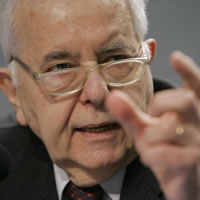
In August 2010, the world lost a great man and one of its most brilliant theoretical physicists when Nicola Cabibbo passed away at the age of 75 in his native Rome, Italy. Cabibbo's work filled in some troublesome holes in the Standard Model of particle physics and explained some long-standing mysteries, making him a giant in the field.
Cabibbo earned his Ph.D. in physics at the University of Rome in 1958, then joined the Italian National Institute of Nuclear Physics (INFN). He came to America for a period in the early 1960s, working at the Lawrence Berkeley National Laboratory and Harvard University, then went home to Italy. After about a year at the University of Aquila, he returned to the University of Rome, where he spent the remainder of his career. Along the way, he served as president of the INFN from 1983 to 1992, and as president of the Pontifical Academy of Science from 1993 until his death.
Best known for his work on the weak force, one of the four fundamental forces in the Standard Model, Dr. Cabibbo first made his mark in the world of theoretical physics in 1963, with the publication in Physical Review Letters of his paper "Unitary Symmetry and Leptonic Decays." He addressed some puzzling unresolved questions involving quarks and how they changed from one type to another. The paper introduced the "Cabibbo angle," a matrix structure which describes how quark types (or "flavors") can "mix" via the weak force. Aside from solving these particular questions, Cabibbo's concepts formed the basis for the development of similar constructs by theoreticians to fit the discovery of two new quark types into the Standard Model, and essentially pointed the way for the later development of electroweak theory. Cabibbo's paper has become the most cited of the more than 350,000 physics papers published since 1893.
This seminal contribution to elementary particle theory would in itself be enough to confirm Dr. Cabibbo's place in the scientific pantheon, but he went on to do further important work in areas such as electron-positron annihilation, beta decay, and other aspects of quantum chromodynamics. In recent years, he concentrated on developing ways to use supercomputers to attack new problems in fundamental physics. Both as a president of INFN and the Pontifical Academy, he worked tirelessly for the advancement and recognition of Italian science and scientists—not only the current and future generations, but even the past, championing the rehabilitation of Giordano Bruno, the famous Italian philosopher and astronomer burned at the stake by the Church for heresy in 1600.
The lasting impact of Nicola Cabibbo's enormous contributions to physics is undeniable. As with all great scientists, Cabibbo's true legacy lies not in his accolades, but in the questions he answered, the students and colleagues he inspired, and the light that he shone into some of the Universe's dark corners.
Information as of April 2011

